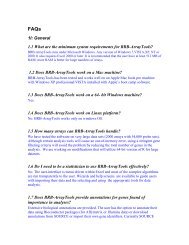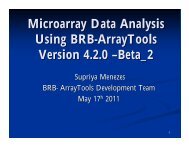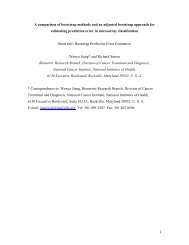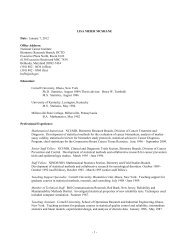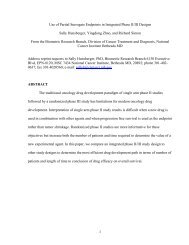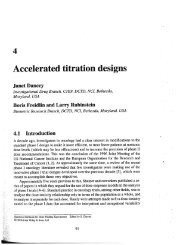Identification of Pharmacogenomic Biomarker Classifiers in Cancer ...
Identification of Pharmacogenomic Biomarker Classifiers in Cancer ...
Identification of Pharmacogenomic Biomarker Classifiers in Cancer ...
You also want an ePaper? Increase the reach of your titles
YUMPU automatically turns print PDFs into web optimized ePapers that Google loves.
The patients <strong>in</strong>cluded <strong>in</strong> a developmental study <strong>of</strong> a pharmacogenomic biomarker to be<br />
used <strong>in</strong> drug development should be appropriate to enable identification <strong>of</strong> patients who<br />
are most likely to benefit from the new drug <strong>in</strong> a pivotal study. For example, suppose that<br />
the pivotal study <strong>in</strong>volves advanced disease patients who have failed first l<strong>in</strong>e treatment<br />
and <strong>in</strong>volves compar<strong>in</strong>g survivals for patients receiv<strong>in</strong>g the new drug to survivals for<br />
patients receiv<strong>in</strong>g palliative care. Patients from s<strong>in</strong>gle arm phase II trials <strong>of</strong> the new<br />
drug could be used to develop a pharmacogenomic biomarker classifier <strong>of</strong> those patients<br />
likely to respond to the new drug. Dobb<strong>in</strong> and Simon ( ) have studied sample size<br />
considerations for developmental studies <strong>of</strong> predictive b<strong>in</strong>ary classifiers and have<br />
<strong>in</strong>dicated that generally at least 20 cases <strong>in</strong> each class are required. Consequently, a phase<br />
II database conta<strong>in</strong><strong>in</strong>g at least 20 responders and 20 non-responders would be needed for<br />
the development <strong>of</strong> a pharmacogenomic classifier to be used <strong>in</strong> the subsequent pivotal<br />
trials. This may require a larger phase II developmental program than is conventional.<br />
If the pivotal study <strong>in</strong>volves comparison <strong>of</strong> outcome for patients receiv<strong>in</strong>g a standard<br />
regimen C versus those receiv<strong>in</strong>g C plus the new drug, then development <strong>of</strong> a gene<br />
expression based classifier is more complex. The classifier could be developed based on<br />
phase II studies <strong>of</strong> patients receiv<strong>in</strong>g C plus the new drug, but unless one also studied<br />
patients receiv<strong>in</strong>g C without the new drug one would not know whether prediction was<br />
drug specific or just reflected general prognostic features <strong>of</strong> the tumors.<br />
It is possible to develop pharmacogenomic predictors <strong>of</strong> risk <strong>of</strong> tumor progression rather<br />
than tumor response. Even if the patients are receiv<strong>in</strong>g the <strong>in</strong>vestigational drug as a<br />
10



